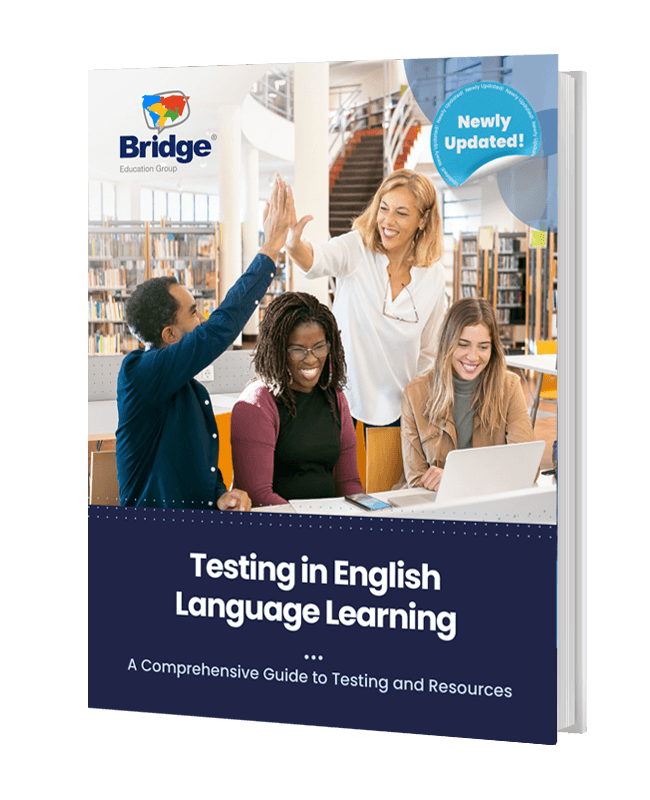Artificial Intelligence (AI) seems to be everywhere these days. Many industries are incorporating it into their day-to-day operations, and English Language Training (ELT) is no exception. AI tools for assessment are employed by teachers looking to better meet student needs. Today, there are several ways to use AI for placement, leveling, and progress monitoring to help educators personalize teaching strategies, learning content, and materials. Let’s look at ways you can use AI tools to personalize your teaching.
Interested in teaching students how to prepare for English proficiency tests? Learn more about Bridge Micro-credentials in Teaching TOEFL Test Prep, Teaching IELTS Exam Prep, and Teaching PTE Test Prep.
Adaptive placement tests
An adaptive placement test in ELT is an assessment designed to determine a learner’s proficiency level in English. What sets adaptive tests apart is their dynamic nature – the difficulty of the questions adjusts based on the responses. As the test-taker progresses through the test, the system adapts, offering simpler or more challenging questions depending on the accuracy of previous answers.
This sort of test is one of the best AI tools for placement as it can assess students’ proficiency levels in reading, writing, listening, and speaking. It involves a blend of AI technologies, natural language processing (NLP), and machine learning algorithms.
You can create your own assessments through AI assistants like ChatGPT or Claud.ai, incorporating CEFR standards to ensure the validity and reliability of your assessments, or you can make use of assessments from test-makers such as:
- Pearson’s Level Test
- Bright Language tests
- Avant Place
- Cambridge English Placement Tests
- TOEFL ITP
One of the benefits of artificial intelligence is that it’s usually built to save time. These adaptive tests are an example of efficiency as they’re designed to pinpoint a test-taker’s proficiency level with a minimal number of questions adapted for the test-taker based on their responses, making these tests more time-effective than traditional linear tests.
The final results provide a detailed analysis of the student’s strengths and weaknesses across different language skills or specific, targeted skills. This information is valuable for English language professionals, allowing them to tailor instruction, assignments, and class resources to meet specific learning needs.
Learn about ways to leverage English proficiency testing in academics and employment.

AI-powered formative assessment tools
Through AI-powered formative assessment tools, educators can monitor each student’s performance in real-time, identifying needs and customizing instruction as needed. These short, targeted assessments can help you adapt your students’ learning path on the go to improve mastery of specific skills. Some examples of AI-powered formative assessment tools include:
- Flow Speak
- Quizizz
- ClassPoint.io
Flow Speak is an app students can use to practice English speaking that provides students with opportunities for additional practice and AI-powered feedback, and teachers with an admin dashboard to track and assess student progress.
One of the biggest benefits of using AI tools for formative assessments is the data they provide, which completes the analysis of student performance for you. Using tools like Quizizz and ClassPoint AI, you can analyze writing samples, speech patterns, comprehension abilities, grammar, vocabulary, and more in real-time, and capture a clear snapshot of student abilities and specific areas that need further focus.
Bridge Languages teachers, who provide online private and small group corporate language training, use AI tools in a variety of ways to maximize the effectiveness and efficiency of their teaching practices.
“Teachers can use AI-powered apps to help determine which areas students struggle with the most and identify learning gaps more easily,” said Bridge Teacher Experience Manager Karina Zew.
“Also, with the incorporation of ChatGPT into our lives, teachers can improve exercises focusing on certain aspects of learning. For example, teachers could input a gap-fill exercise and ask ChatGPT to create a role-play scenario to go with that exercise and connect to the overall topic of the lesson. This increases efficiency and helps teachers deliver consistent classes, reducing organization and planning time to a minimum.”
Take a deep dive into the spectrum of English language exams and resources with the free guide to
Testing in English Language Learning
DownloadAI-integrated summative assessments
Many test-makers use AI to make their tests adaptive and to grade. These high-stakes tests provide certification of English language proficiency for acceptance to universities, immigration, and employment. Some examples of tests that use AI for adaptive tests and for ensuring objective grading include:
- The Bright Test by Bright Language
- The Duolingo English Test (DET) by Duolingo
- iTEP tests
- LanguageCert
In many cases, tests such as these are used to benchmark and evaluate learning over time. For example, Cinthia Cristaldi, Bright Language Business Development Consultant, said language schools often use Bright Language tests at the beginning and end of their courses to gain data on the effectiveness of their teaching strategies and see trends in student proficiency levels. Bright Language tests are often used by companies whose employees are taking Business English courses as part of their English language training programs.
Some test-makers even use AI tools to proctor the speaking portion of their tests. Familiarization with the test format and features is important for teaching Business English or any other type of English language course that prepares students for an English language proficiency test.
Testing companies also use AI to prevent plagiarism and other forms of unethical behavior in test-takers, as Jim Brosam, former iTEP President, pointed out. iTEP uses AI-powered plagiarism recognition software to safeguard against cheating.
Teachers may also use an AI assistant to create their own summative assessments, including appropriate CEFR standards and other applicable criteria to ensure the validity of their test to assess a learner’s mastery of skills. Assessments can be made using general AI assistants such as ChatGPT or Claude.ai or with an education-focused AI platform such as MagicSchool.ai.

Learning platforms with AI features
If you teach online or for a school, institute, or company that uses a learning platform, you likely already have access to some fantastic AI tools. Most LMS or learning platforms have AI features that can be used in a variety of ways, such as generating detailed progress reports, grading and offering feedback, and more, to help guide and personalize teaching strategies. Here are some examples of how they achieve this:
- Performance Metrics: Platforms with AI features can generate detailed performance analytics, allowing teachers to track metrics like completion rates, time spent on tasks, and success rates on assessments. This data helps gauge overall engagement and understanding.
- Feedback Analysis: AI tools often provide automated feedback on assignments and exercises. Teachers can analyze this feedback to understand common mistakes, recurring challenges, and areas where students require additional support.
- Communication Analytics: Some platforms have AI communications for students, such as AI-powered tutoring and chatbots, which teachers can access to gain insights into student questions, concerns, and the need for clarification, helping teachers address challenges promptly.
If you are teaching English online independently, there are many different e-learning platforms with a variety of AI tools. Researching potential platforms can help you identify which one has the tools that will be most beneficial to you. Some learning platform examples include:
AI-assisted grading and feedback tools
By incorporating automated grading and feedback systems, English teachers can strike a balance between efficiency and engaging instruction. This approach allows teachers to provide timely or even real-time feedback, focus on higher-order skills, and create a more effective learning environment.
Some examples of AI-assisted grading tools include:
- Gradescope by Turnitin
- Formative AI
- Crowdmark
You can also use general AI tools like ChatGPT to grade essays or other writing responses to open-ended questions. You’ll need to input the essay and establish grading criteria to guide the generated response. Many learning platforms already have integrated AI tools for automated grading, particularly simple grading tasks with clear answers such as fill-in-the-blank responses and multiple choice.
With any AI tool for assessment, it’s still important to incorporate individualized feedback for your ESL students whenever possible. For example, while automated systems handle objective assessments, teachers may want to focus on providing more detailed and constructive feedback for subjective assignments like essays or open-ended questions. This combines the efficiency of automation with the personalized touch of a teacher’s input.
In addition, teachers can use automated grading as an opportunity to encourage student reflection. They can include questions or prompts alongside the feedback to encourage students to think about their learning process and how they can improve.
By incorporating AI tools for assessment into their teaching practices, ESL/EFL teachers can enhance the effectiveness of their instruction, with placement, leveling, and progress monitoring becoming streamlined.
While artificial intelligence tools offer significant benefits, English teachers must approach their integration thoughtfully, maintaining a balance between technology and human interaction. The right combination of AI and teacher expertise can create a powerful and effective learning environment for students.








